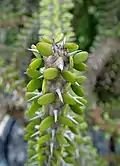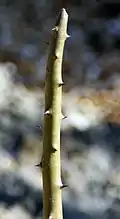Alluaudia
Alluaudia is a genus of flowering plants in the family Didiereaceae. There are six species, all endemic to Madagascar.[1]
| Alluaudia | |
|---|---|
 | |
| Alluaudia procera | |
| Scientific classification | |
| Kingdom: | Plantae |
| Clade: | Tracheophytes |
| Clade: | Angiosperms |
| Clade: | Eudicots |
| Order: | Caryophyllales |
| Family: | Didiereaceae |
| Subfamily: | Didiereoideae |
| Genus: | Alluaudia (Drake) Drake |
| Species | |
|
6, see text | |
Most occur in the southwestern subarid forest-thicket vegetation of the island.[2]
Spines are arranged around the leaves as a defense against herbivores. The spines are several meters above the ground, and probably evolved in response to herbivory by now-extinct lemurs, such as Hadropithecus. Several lemur species living today feed heavily on Alluaudia, such as the ring-tailed lemur (Lemur catta) and the white-footed sportive lemur (Lepilemur leucopus).[3]
Species
| Image | Scientific name | Distribution |
|---|---|---|
 | Alluaudia ascendens (Drake) Drake 1903 | Madagascar |
 | Alluaudia comosa (Drake) Drake 1903 | SW Madagascar. |
 | Alluaudia dumosa (Drake) Drake 1903 | southern coastal Madagascar |
.jpg.webp) | Alluaudia humbertii Choux 1934 | Madagascar |
 | Alluaudia montagnacii Rauh 1961 | Madagascar |
 | Alluaudia procera (Drake) Drake 1903 | Madagascar |
References
- Alluaudia. Madagascar Catalogue. eFloras.
- Schatz, G., et al. Modeling of endemic plant species of Madagascar under climate change. In: Assessing the Impact of Climate Change on Madagascar's Livelihoods and Biodiversity. Conference. Antananarivo, Madagascar, 28 January 2008.
- Crowley, B. E. and L. R. Godfrey. (2013). Why all those spines?: Anachronistic defences in the Didiereoideae against now extinct lemurs. South African Journal of Science 109(1-2), 1-7.
External links
- GRIN Species Records of Alluaudia. Germplasm Resources Information Network (GRIN).
- http://worldofsucculents.com/how-to-grow-and-care-for-alluaudia/
This article is issued from Wikipedia. The text is licensed under Creative Commons - Attribution - Sharealike. Additional terms may apply for the media files.
